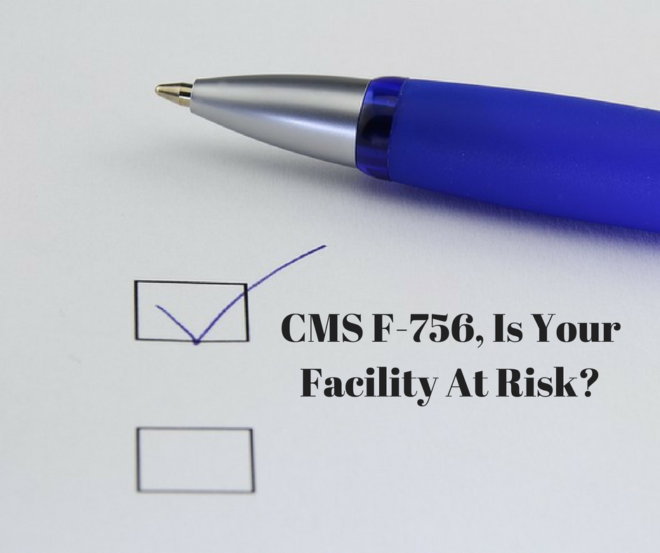CMS F756 is a deficiency that most often results from unnecessary medications or a lack of action based upon the pharmacist’s recommendation. I left off on Pharmacy Services F755 which you can learn more about here. F756 is classically referred to as the “Drug Regimen Review” tag. Let’s take an example. We have a patient who has been on Xanax 0.25 mg every 8 hours as needed for 2 months. With recent changes in the new pharmacy services f-tags, PRN (as needed) psych medications should now be limited to a max of 14 days and if residents need to be on these medications for longer than that, there should be documentation. Using this case, here’s some scenarios on how a facility could get cited for F-756
- There is no documentation as to why this was continued beyond the 14 days (would likely be cited under F758 as well) AND the consultant pharmacist did not notify the attending physician of this “irregularity”
- The consultant pharmacist wrote a recommendation to address the PRN Xanax, but the physician did not address the recommendation
- The attending physician addressed the recommendation by writing “no change” and did not elaborate as to the rationale for continuing and the consultant pharmacist did not follow up any further
The drug regimen of each resident must be reviewed at least once a month by a licensed pharmacist. (The BOLDED content is directly from the CMS State Operations Manual)
- I have seen a couple of rare cases where this requirement was not met, but every facility can easily fulfill this requirement by employing a consultant pharmacist.
This review must include a review of the resident’s medical chart.
- This language has become a little more strict over the years. The pharmacist needs to review more than just the “drug regimen” or medication list. I have heard of situations (more in the past) of pharmacists simply reviewing the med list. One way that CMS has tried to get pharmacists more involved is to put in the language about pharmacist review of the entire medical record. This does require that the consultant pharmacist have access to all records. Labs and vital signs are two examples of essential components that are necessary to appropriately monitor a patient’s medication regimen.
The pharmacist must report any irregularities to the attending physician and the facility’s medical director and director of nursing, and these reports must be acted upon.
- Here’s where the fun starts… Irregularities is such a vague term and intentionally so. Most often, F756 is given in combination with F757 or F758. You can learn more on how frequently these tags are cited here. When an unnecessary medication deficiency is given, you can bet that surveyors are going to review if the pharmacist notified and alert staff and the prescriber of that irregularity.
Irregularities include, but are not limited to, any drug that meets the criteria set forth in paragraph (d) of this section for an unnecessary drug.
- This is what I was getting at above. If the pharmacist does not recognize a potential unnecessary drug, the facility is at risk of getting “double dipped” with F756 being one of the tags.
Any irregularities noted by the pharmacist during this review must be documented on a separate, written report that is sent to the attending physician and the facility’s medical director and director of nursing and lists, at a minimum, the resident’s name, the relevant drug, and the irregularity the pharmacist identified.
- This is a more recent change as well. The report now MUST be sent to the medical director and director of nursing, not just the attending physician. Make sure you have this process in place and running smoothly. If the medical director asks why they are receiving recommendations for a resident that they are not the attending physician, you can refer them to this regulation.
The attending physician must document in the resident’s medical record that the identified irregularity has been reviewed and what, if any, action has been taken to address it. If there is to be no change in the medication, the attending physician should document his or her rationale in the resident’s medical record.
- Most physicians, NP’s etc. are fine with addressing the recommendation, but many providers are tempted to write “no change” if they don’t want to do anything different. The facility is at risk for deficiency if they do no document the rationale for not changing a medication.
The facility must develop and maintain policies and procedures for the monthly drug regimen review that include, but are not limited to, time frames for the different steps in the process and steps the pharmacist must take when he or she identifies an irregularity that requires urgent action to protect the resident.
- With this piece of the regulation, you’ll not that there is NO requirement for when the irregularity needs to be addressed, other than when urgent action is necessary. It is up to the facility to determine a policy that works best for their team. In my experience, I’ve had a mixed bag of ways to handle pharmacist recommendations. Some facilities would fax them right away, while others would wait until the next provider rounds. In the event of waiting for doctor rounds, there is potential that the pharmacist would do the monthly review twice prior to the physician visit. In that scenario, the pharmacist would have to wait until rounds took place.
For more on Pharmacy Services F-tags and F756, be sure to check out my free webinar!

One thought on “F756 – Spotlight on CMS Pharmacy Services F-Tags”